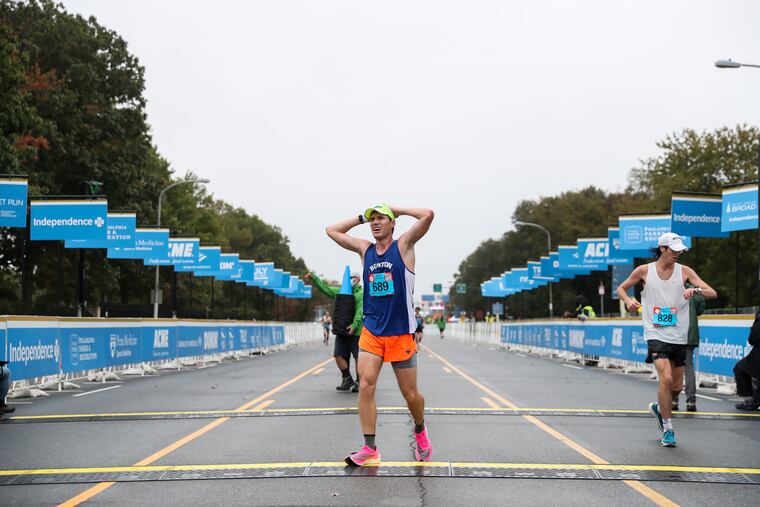How the Broad Street Run times thousands of runners at once
The same technology is used in E-ZPass, and Drexel engineers also are using it to measure vital signs in healthcare settings.

Hidden beneath stickers on 28,000 racing bibs for Sunday’s Broad Street Run are miniature, flexible antennas attached to electronic chips.
The same technology is used in E-ZPass highway tolls, antitheft tags in stores, and inventory control systems in warehouses. Called radio frequency identification (RFID), it is so versatile that at Drexel University, engineers are developing it to measure various health indicators, such as the breathing rates of infants or older people with sleep apnea.
But for the hordes of racers on Sunday, the goal is to capture the one data point that matters: their time.
Dozens of people will be surging across the starting line at one time — all expecting to get an accurate reading of how long it takes them to run 10 miles.
In races such as Broad Street, disposable RFID tags have been commonplace for years, discreetly attached to the numbered bibs that entrants pin to the front of their shirts.
The mass of humanity is separated at the starting line into nine corrals, fastest to slowest, each wave of runners starting 3 to 5 minutes after the one before it.
The clock starts the moment each runner crosses through an invisible “curtain” of radio waves, transmitted by antennas that are hidden beneath mats on the road’s surface.
» READ MORE: Broad Street runners: a sorta true-ish illustrated field guide
This signal is received by a much smaller antenna inside each runner’s tag, said Kapil Dandekar, a Drexel professor of electrical and computer engineering. The signal “wakes up” an attached chip encoded with that runner’s identity, causing another signal to be sent back to the timing system.
And with that, the race is on.
How the antennas work
The antennas on the pavement transmit their signals many times per second, enough to capture every runner at the exact instant the person crosses the line, Dandekar said.
“Even if you’ve got a pretty solid wall of people going through there, it’s possible to differentiate a surprising number of signals,” he said.
Additional sets of antennas are placed on the roadway at the finish line, and at 3, 5, and 7 miles along the way, said David Simms, owner of Simmco Data Systems, a Detroit company that runs the system for the Broad Street Run. That allows runners and spectators to track their progress in real time.
Yet as seasoned racers know, every so often there are glitches, and a runner’s time may be recorded incorrectly or missed entirely. Simms has overseen the timing at Broad Street and the Philadelphia Marathon for decades and says his system is at least 99.7% accurate.
» READ MORE: With registration open, all you need to know about Philadelphia Marathon Weekend
In a large race such as Broad Street, that might mean an incorrect time for just a few dozen entrants. Still, Simms said it bothers him.
“It’s so few people, but it’s bad,” he said. “You ran your heart out.”
In such cases, Simms typically estimates a runner’s time by looking at video for others who crossed the finish line at roughly the same moment.
Simms brings a team of 10 people to set up the mats, controller boxes, and other equipment. Once it’s in place, running the system is fairly straightforward, he said.
“I’m timing Broad Street essentially with one laptop,” he said.
How were runners timed before antennas?
Simms said the antenna system is a vast improvement over the old days of racing, when organizers would rip a perforated tag from runners’ bibs as they crossed the finish line, one by one.
Then came the first generation of bulkier RFID tags, which were attached to runners’ shoes and collected afterward by race organizers for reuse. Today’s RFID tags are simply printed onto a sticker.
Where else can these antennas be used?
More sophisticated RFID antennas are in development in Dandekar’s lab at Drexel. He is exploring the use of antennas woven into the fabric of garments, such as infant onesies.
“As it stretches and contracts, the electromagnetic properties of the tag itself change,” he said. “We can use that to infer how someone’s breathing.”
Another option is using such tags in elder care settings to detect when a diaper is full, he said.
The shape of an antenna determines the frequency to which it is tuned. Seen up close, the interlocking patterns have a certain appeal beyond their function, Dandekar said.
“It almost looks like art,” he said.
On Broad Street this Sunday, when racers clog the four-lane artery through the heart of Philadelphia, their only purpose is science. Runners, take your marks!